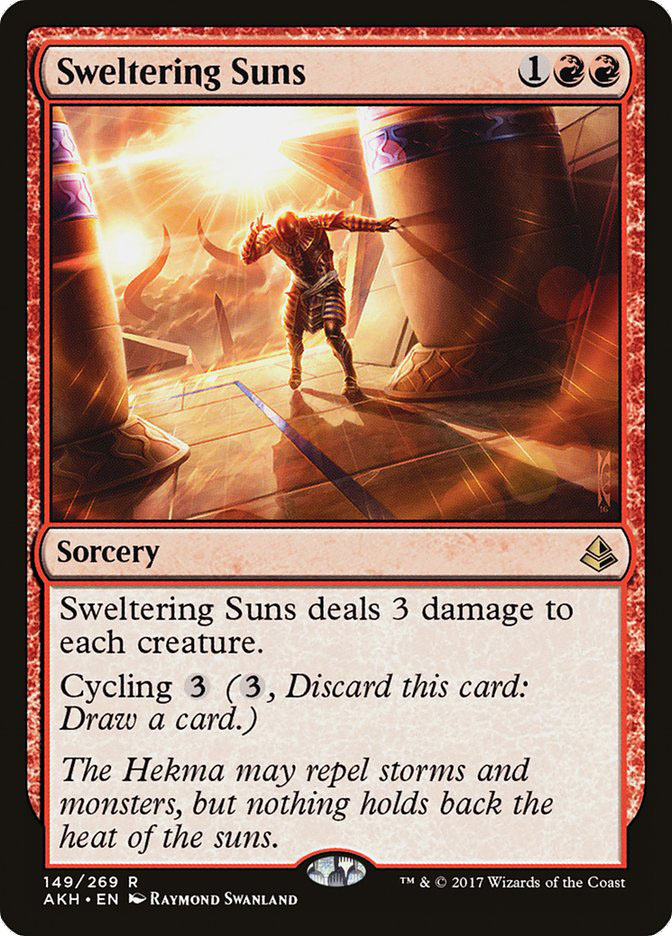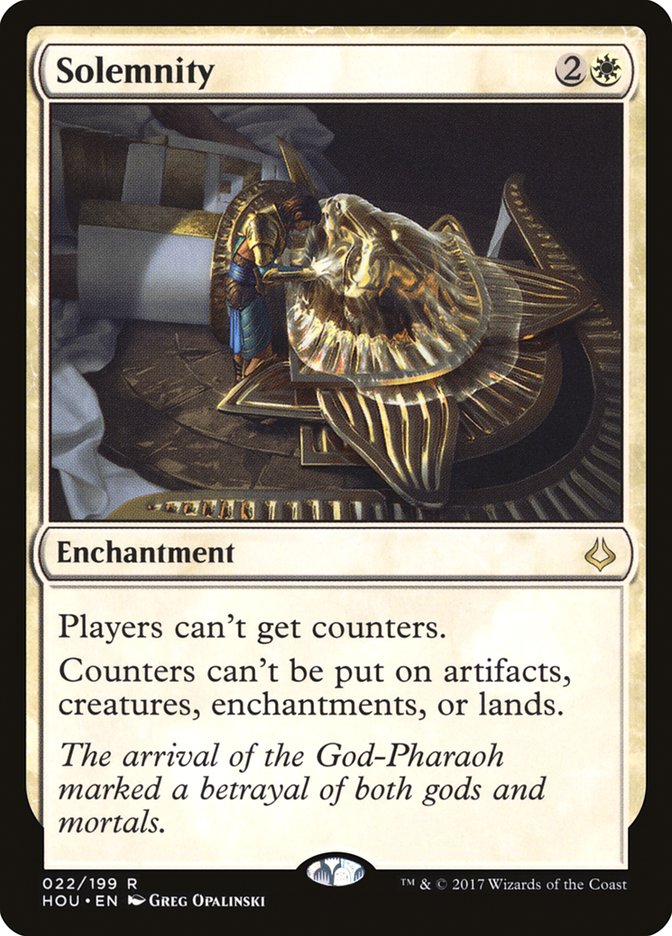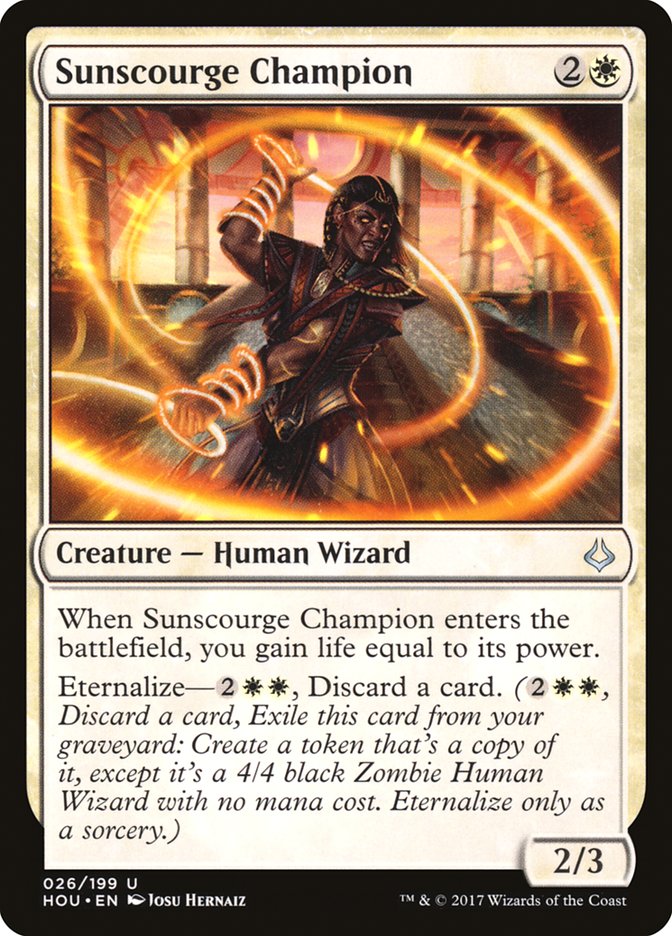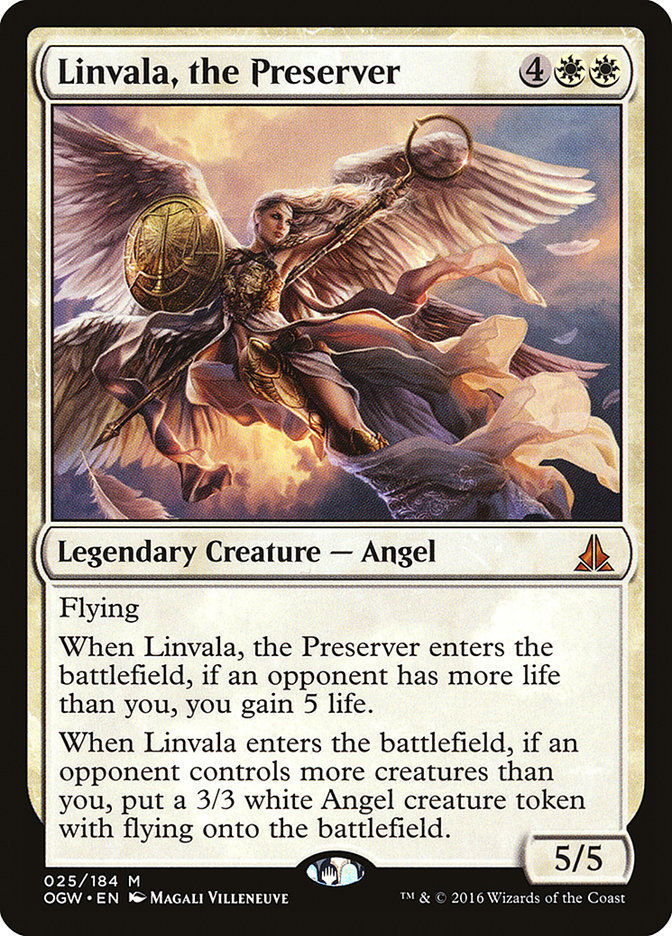I’m absolutely loving Standard today. And I’m far from the only one.
I’ve had this conversation with a lot of people, and it seems like this is a really common opinion. Now, my circles are a bit more biased to the Spike-y side of the Magic universe, but I’ve heard it from less invested players as well. Collectively, we also like a ton of different decks. U/R Control. Ramunap Red. Mardu Planeswalkers. Various God-Pharaoh’s Gift decks. Temur. Zombies. I mean, how does it work that we all are enjoying this format and are at least a teeny bit sad to imagine Ixalan coming out to change things up?
A part of it comes down to the nature of a format that is hemmed in by Red Aggro. Simply put, when Red Aggro plays gatekeeper for a format, this is generally a very freeing place to be, because such a straightforward deck can be answered in traditional ways. This also means that innovators get the opportunity to find sensible ways to answer the Big Bad of a format and still be their own deck.
Take an example from one of my favorite innovators:
Creatures (27)
- 1 Pilgrim's Eye
- 4 Thraben Inspector
- 2 Cataclysmic Gearhulk
- 4 Angel of Invention
- 4 Glint-Nest Crane
- 4 Minister of Inquiries
- 4 Walking Ballista
- 4 Champion of Wits
Lands (24)
Spells (9)

Another person playing this deck beat me in the middle of Day 2, the incredibly friendly Edwin Eng.
Creatures (25)
- 4 Thraben Inspector
- 2 Cataclysmic Gearhulk
- 3 Angel of Invention
- 4 Glint-Nest Crane
- 4 Minister of Inquiries
- 4 Walking Ballista
- 4 Champion of Wits
Lands (25)
Spells (10)

These decks are barely different but they have great game against Ramunap Red because they run low-to-the-ground creatures that can either trade or better, and the game can easily get wrapped up by either an Angel of Invention or Walking Ballista, especially if the namesake of the deck, God-Pharaoh’s Gift, enters into the mix.
Of course, this deck was only barely on the radar of anyone thinking seriously about Standard even a few short weeks ago. So what happened?
The Journey of Standard
There are a lot of ways that Standard looks different now, online and “on paper,” from how it did closer to the time that Hour of Devastation was released.
In the initial discovery of the format, not very many things had been found by players that could consistently beat Red Aggro. black-based decks that preyed upon Red Aggro.
So, for the Pro Tour, the newly dubbed Ramunap Red dominated numerically and black-based decks dominated performance-wise. This lesson wasn’t obvious without a deep dive into the numbers, though. With that data, you’d conclude that the following decks were the most successful, in terms of performance: Ramunap Red, Mono-Black Zombies, B/G Constrictor, Temur Energy, and (since largely unseen) R/B Aggro.
A week after Pro Tour Hour of Devastation in Kyoto, we saw the result of the subtle lessons lock in, with black decks forcing their way in and taking down the top slot:
Creatures (21)
- 1 Kalitas, Traitor of Ghet
- 4 Relentless Dead
- 4 Diregraf Colossus
- 4 Cryptbreaker
- 4 Lord of the Accursed
- 4 Dread Wanderer
Lands (25)
Spells (14)

Playing black paid off, and while there was a sizable Ramunap Red population, it barely showed up to the party. In addition, we saw the first instance of an impressive result: the brothers Nelson/Baumeister both in the Top 8 with near-identical decks.
Creatures (21)
- 4 Catacomb Sifter
- 4 Sylvan Advocate
- 3 Verdurous Gearhulk
- 4 Winding Constrictor
- 2 Rishkar, Peema Renegade
- 4 Walking Ballista
Planeswalkers (3)
Lands (24)
Spells (12)

Brad’s deck changed a Catacomb Sifter to a Nissa, Voice of Zendikar and an Aethersphere Harvester to a fourth Grasp of Darkness, but otherwise their decks were the same, albeit with a few more minor differences in the sideboard.
To me, the real genius of their deck choice, despite not taking the top slot, is that they didn’t just choose a powerful black-based deck that could beat Ramunap Red, but they chose the deck that was lesser in popularity at the Pro Tour and more varied in construction, thus putting themselves less in the crosshairs of those players who may have tried to make a metagame move one step ahead of them.
Another important and frankly impressive result was seeing two Wisconsin players both make their first GP Top 8s piloting Matt Severa’s Mardu Vehicles deck:
Creatures (19)
- 2 Archangel Avacyn
- 4 Thraben Inspector
- 2 Pia Nalaar
- 4 Scrapheap Scrounger
- 4 Toolcraft Exemplar
- 3 Walking Ballista
Planeswalkers (2)
Lands (25)
Spells (14)

The big departure for this deck involves a simple but important innovation:
Gideon sucks.
Now, obviously, that is hyperbole. But in the context of the current moment, there sure is a lot of aggro running around and much of it is quite cheap aggro. Dropping a Gideon is often a good way to spend an entire turn to gain four life. Gideon, Ally of Zendikar is awesome at preying on slower decks, but not so great when nearly every deck is great at attacking and the gatekeeper of the format, Ramunap Red, is omnipresent.
Speaking of this season’s Big Bad, while it is important to note the near-absence of Ramunap Red in the Top 32, there was another huge innovation in Grand Prix Minneapolis that made it relevant again:
Creatures (23)
- 4 Falkenrath Gorger
- 4 Bomat Courier
- 2 Kari Zev, Skyship Raider
- 3 Hazoret the Fervent
- 4 Ahn-Crop Crasher
- 2 Soul-Scar Mage
- 4 Earthshaker Khenra
Planeswalkers (2)
Lands (24)
Spells (11)

The innovation from Matt Sikkink Johnson was a sideboard that could handle the problematic Zombies matchup.
If you look at this sideboard, you can see that it does something I personally love my red decks have access to being able to do: go big and dodge the pure hate for aggression. Even more importantly, for the moment, is being able to specifically go toe-to-toe with Zombies by siding in Sweltering Suns and more controlling cards like Glorybringer and Chandra, Torch of Defiance.
This list was so successful that, where Ramunap Red was virtually nonexistent at GP Minneapolis, it was a huge presence at GP Denver. In the GP Denver Top 8, Ramunap Red took one semifinalist and two quarterfinalist spots. Mono-Black Zombies and W/U Monument, by contrast, had one quarterfinalist each.
Red didn’t just take three slots in the Top 8; it was well-represented throughout the top tables of GP Denver. While one of the Top 8 finishers didn’t use Sikkink’s plan of Sweltering Suns, the other two did, and I can testify that I saw a lot of Sweltering Suns at the top tables.
Perhaps the bigger story was the follow-up, not of a deck, but of two players. Here was the sequel to the incredible Brad/Corey finish; the brothers came back at the next major event two weeks later, chose an entirely new deck, and crushed it, with Brian Braun-Duin joining them at the very top of the event, only losing to each other in the Top 8.
Wow.
Creatures (24)
- 4 Longtusk Cub
- 4 Bristling Hydra
- 4 Whirler Virtuoso
- 4 Servant of the Conduit
- 4 Rogue Refiner
- 3 Glorybringer
- 1 Rhonas the Indomitable
Lands (22)
Spells (14)

The selection of an entirely new archetype is an impressive one for many reasons. Correctly understanding the tides of a metagame can be a difficult task. In the past, I’ve personally been impressed by several players’ ability to do so – Hall of Famer Ben Stark, for example – but it is also one of the skills that makes Brad Nelson stand out. While I can’t speak to how much the deck selection was Nelson’s or Baumeister’s or Braun-Duin’s, especially given the incredible value of archetype knowledge and deck skill in this format, making a switch to another deck to such great success is a big deal.
Earlier this week, Ross Merriam noted some of the reasons Temur Energy as a great choice. One is that the deck is a great choice in a Fatal Push world like we saw the week prior in Minneapolis. Seven of the Top 8 were Fatal Push decks.
Just like Red Aggro, the Temur Energy deck they brought to bear also has great sweep against a Zombies deck. Chandra, Flamecaller and Radiant Flames can take care of a mass of Zombies, and in conjunction with Glorybringer, can basically keep that deck completely contained. This plan is also very effective against a B/G Constrictor plan as well.
The next logical step in the metagame is the emergence of a deck that is solid against Temur Energy and Ramunap Red. Perhaps this will be something entirely new.
One possibility is something like I saw in the hands of Jonathan Job.
Creatures (26)
- 3 Eldrazi Displacer
- 4 Thought-Knot Seer
- 4 Matter Reshaper
- 3 Archangel Avacyn
- 4 Thraben Inspector
- 4 Selfless Spirit
- 4 Walking Ballista
Lands (25)
Spells (9)

This deck impressed the hell out of me.
If the name Jonathan Job sounds familiar, it may be that you spent time playtesting against one of his decks earlier this year:
Creatures (28)
- 2 Eldrazi Obligator
- 2 Reality Smasher
- 3 Thought-Knot Seer
- 4 Falkenrath Gorger
- 2 Kari Zev, Skyship Raider
- 2 Glorybringer
- 1 Hazoret the Fervent
- 4 Ahn-Crop Crasher
- 4 Soul-Scar Mage
- 4 Earthshaker Khenra
Planeswalkers (2)
Lands (24)
Spells (6)

This build of Ramunap Red was incredibly influential in all of the work that would lead to our current metagame; but for a single match point, Job would have made Top 8 with this deck. Personally, I witnessed him lose a close match, stuck on three land in Game 3 despite having 25 lands in his deck, and maybe more if he sideboarded in an extra copy!
There is a way that this deck hearkens back in time over a year:
Creatures (22)
- 4 Knight of the White Orchid
- 2 Ayli, Eternal Pilgrim
- 4 Eldrazi Displacer
- 4 Thought-Knot Seer
- 3 Hedron Crawler
- 1 Matter Reshaper
- 4 Archangel Avacyn
Planeswalkers (4)
Lands (26)
Spells (8)

Job’s Eldrazi deck has a number of powerful plans while sticking to a simple single color to join the colorless menace. Archangel Avacyn and Selfless Spirit make his already potent Eldrazi hard to kill, as well as being a great combo with each other. Eldrazi Displacer does a ton of work in conjunction with numerous cards in the deck. Shefet Dunes is an incredible dual land for Job, as well as shortening the clock more than occasionally.
The most bizarre card in his sideboard, though, has to be this little number:
What a brilliant sideboard choice. If you are a Temur Energy deck, you’re stuck with whatever energy you currently have and whatever other counters you currently have. After that, you’re done. I do wonder if three copies of this card is correct, but it can’t be said that the card isn’t incredibly effective. I know that if I were playing any deck with white, I’d definitely want the first copy of this card. Diminishing returns might make me not want additional copies, but I do have a feeling that a part of Job’s success was likely this card’s incredible power against Temur Energy.
Just saying “gain life” while doing anything else relevant can be enough to make the Ramunap Red matchup sufficiently managed. At that point, all you have to do is keep control of the bBig” elements of the deck like Hazoret the Fervent and Chandra, Torch of Defiance. Cards like Cast Out can take care of anything, and Stasis Snare is great against the red God.
I sat next to Job more than a few times during the event, and one thing that I thought would have been helpful were a few cheaper cards. Thraben Inspector is the only truly cheap card in the deck; sometimes it felt like Job was stuck making single plays each turn, and I found myself wishing there was more he could do in a turn, especially on defense. Without having tested the deck yet, I feel like I’d need more experience to know for sure, but I do find it telling that the older deck from last year ran 26 land and a great deal of mana acceleration.
Here are just a few cards I’m interested in trying out in the 75 after I play Job’s original list:
Of these, I find Quarantine Field the most exciting, simply because the card is so absurdly powerful. Presuming you can stay alive, it can decimate a battlefield of powerful cards.
Aside from the intrigue of Mono-White Eldrazi or other newcomers, each of the currently active decks out there could work in shifts to accommodate the threat of Temur Energy and Ramunap Red. The specifics would vary from archetype to archetype, but would need to accommodate an understanding of both of these decks ability to play aggressive and switch to more controlling with red sweeper spells.
Perhaps it could be “going retro” with an update to the archetype that has since disappeared but was the most successful deck from Pro Tour Hour of Devastation, albeit only played by seven players.
Creatures (25)
- 2 Eldrazi Obligator
- 4 Falkenrath Gorger
- 4 Bomat Courier
- 2 Kari Zev, Skyship Raider
- 3 Hazoret the Fervent
- 2 Soul-Scar Mage
- 4 Earthshaker Khenra
- 4 Ammit Eternal
Lands (23)
Spells (12)

Here is one potential take on that update:
Creatures (23)
- 4 Falkenrath Gorger
- 4 Bomat Courier
- 2 Kari Zev, Skyship Raider
- 3 Hazoret the Fervent
- 2 Soul-Scar Mage
- 4 Earthshaker Khenra
- 4 Ammit Eternal
Planeswalkers (2)
Lands (24)
Spells (11)

The Road to DC Is Paved with Red and Green
Grand Prix DC is almost here, and while I expect to continue playing Torrential Gearhulk, the metagame is still wide open. If you plan on having success at that event or any other, I think you really do need to target Temur Energy and Red Aggro. As I said a week ago, if you take your eyes off the ball with Ramunap Red, it will punish you.
Temur Energy has taken the crown from Zombies and B/G Constrictor, which took it from Red Aggro. In DC, I’ll hope to take it with U/R Gearhulk. Whatever you choose to try to take that crown with, make sure you’re prepared for the aggressive potential of both of those colors as well as their sweepers and controlling cards.









